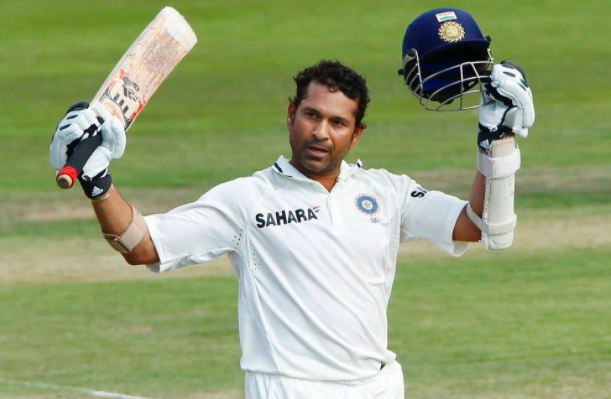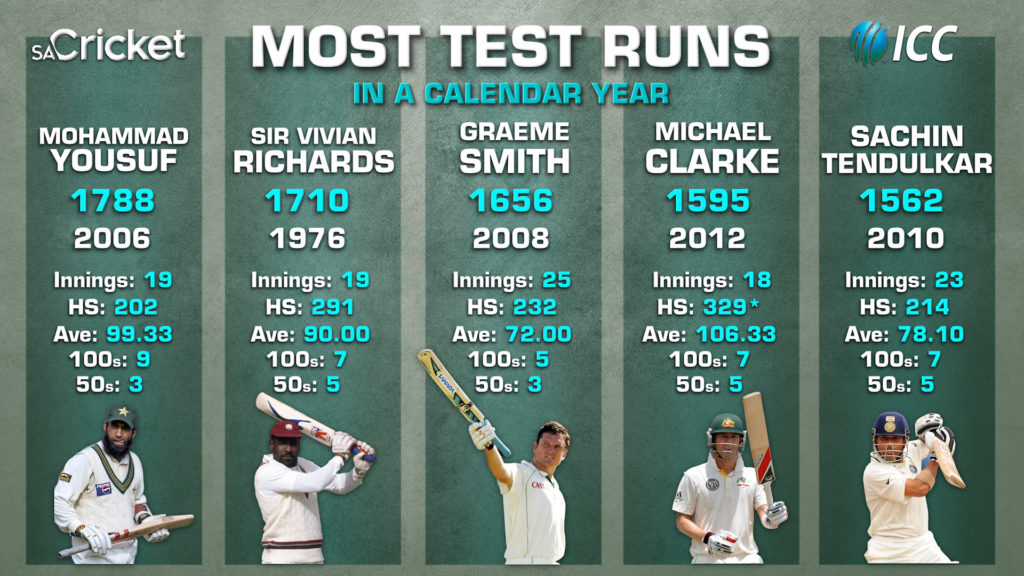In the first piece of a two-part series, SA Cricket magazine editor RYAN VREDE dissects the records of the top five Test run-scorers in a calendar year, and re-ranks them according to difficulty and significance.
Runs are runs, most would say. It’s hard to argue with that, but I’ll try anyway. Some runs mean more than others because of the calibre of the opposition attack, whether they’re scored in home comfort or on tour, the pitch and the match situation, among other circumstances.
I have the highest respect for each of the men on the list, but their records in the period in question demand closer scrutiny.
This is where I landed. Ladies and gentlemen, my alternate top five …
5. Mohammad Yousuf
Controversial from the jump, I know. But closer inspection of Yousuf’s record exposes it as deeply misleading.
India tour of Pakistan
His year started brilliantly with a first-innings 173. The Lahore pitch was extremely flat, though, and India’s attack was toothless. Anil Kumble, just two years from retirement, bowled nearly 40 overs. Harbhajan Singh was the only other notable bowler in an attack where only one of the seven bowlers used went at under four runs per over. In testimony to the wicket’s flatness, India replied with 410-1 in a rain-interrupted draw.
The late Bob Woolmer, then Pakistan coach, was made to defend the Faisalabad wicket as well, claiming they wanted a pitch with bounce for the second Test. Instead they got a road. Yousuf scored 65 in a first-innings total of 588, to which India replied with 603. Yousuf got 126 in the second dig before running himself out. He would otherwise still be batting today. The match ended in a tame draw. Renowned cricket scribe S Rajesh, wrote in summary: ‘Completely insipid and lifeless pitches have ensured that a series which was eagerly looked forward to is ending up as one of the most boring, and a terrible advertisement for Test cricket.’
Yousuf’s second-innings 97 helped set up a winning target in the third Test, and for Pakistan to claim a series victory over their bitter rivals.
A Test in Kandy, where Yousuf was bowled by Muttiah Muralitharan (Murali from here on out) for 17, preceded a tour of England.
Pakistan tour of England
Yousuf was the standout performer with the bat in the first Test at Lord’s, scoring a first innings 202 after coming to the wicket at 28-2. This was notable, given that it came against the core of the bowling attack that had beaten Australia in the 2005 Ashes series. His 48 in the second innings helped Pakistan hold out for the draw.
Pakistan were rolled for low scores in the second Test and lost by an innings, but 192 in the third Test in Leeds set up a first-innings lead. The tourists collapsed for 155 in pursuit of 323, with Yousuf run out for eight.
Yousuf’s form continued in the fourth Test with a first-innings 128, but the match was famously abandoned after umpire Darrell Hair docked Pakistan five penalty runs for ball-tampering. Yousuf was named joint Player of the Series with Sir Andrew Strauss.
West Indies tour of Pakistan
Yousuf piled on the runs against one of the weakest Windies attacks in history and on some of the flattest decks in the game, with scores of 192, 56, 191 (a match-saving effort in Multan), 102 and 124 to round out the year.
4. Sachin Tendulkar
The ‘Little Master’ deserves great respect but his run plunder in 2010 has to be seen in context.
His year started off with centuries in Chittagong (155*) and Dhaka (143) against a Bangladesh attack comprising butchers, bakers and candlestick makers. The true test would come next …
SA tour of India
The Proteas brought an attack that featured Dale Steyn, Morné Morkel and Jacques Kallis. Steyn ripped the Indians to shreds in the first innings of the first Test in Nagpur, taking seven wickets, including Tendulkar’s for just seven. However, Tendulkar showed his class with a century in the second innings while all around him succumbed. He carried his form into the second Test in Kolkata, scoring 106 in a massive first-innings effort that set up victory.
India tour of Sri Lanka
Out for just eight as one of Murali’s five wickets in the first innings, but got 84 in the follow-on in a losing effort.
Then came Colombo and the flattest wicket in all of history. The hosts got 642 declared. India responded with 707, Tendulkar getting 203 against an attack that didn’t include Murali. The less said about the curatorship of this wicket the better.
Tendulkar then scored 41 and a critical second-innings 54 as India chased 258 to win the third Test against a Murali-less Sri Lanka.
Australia tour of India
Australia have had many potent bowling attacks in their Test history but the group they brought to India was one of the weakest. Mitchell Johnson was the only standout name. The rest – Ben Hilfenhaus, Doug Bollinger, Nathan Hauritz, Shane Watson, Marcus North and Peter George, who played just one Test for Australia – were decidedly average.
Sachin must have been salivating. He bombed in the first innings of the first Test in Mohali, but scored an important 38 on a tough wicket as India chased 216 with a wicket in hand.
In the second Test, his first-innings 214 in Bengaluru was immense, and he then saw the Indians home with an unbeaten 53 in pursuit of 207.
New Zealand tour of India
Daniel Vettori was the only notable bowler the Black Caps brought on this tour. Chris Martin was dependable, but the likes of Hamish Bennett, Jesse Ryder and Jeetan Patel weren’t world class. Despite this, Tendulkar’s scores of 40, 12 and 13 across the first two Tests weren’t great. He contributed 61 in the first innings of the third Test in Nagpur, helping to set up an innings victory.
India tour of SA
Steyn, Morkel and Kallis were waiting for the Indians on the greener grass of home and when Morkel ripped through the tourist’s lineup in the first innings of the first Test at Centurion, Tendulkar falling for 36, the scene was set. Tendulkar’s defiant 111* in the second innings couldn’t prevent an innings defeat, though. India won the second Test in Durban, but Tendulkar failed with scores of 13 and 6.
To be continued …








